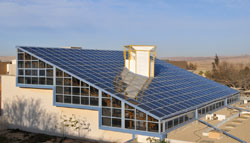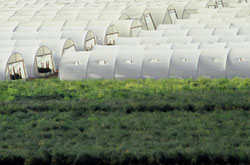Israel’s Big Green Future
On the Bergman campus of Ben-Gurion University (BGU), located in the city of Beer-Sheva on the northern edge of Israel’s Negev Desert, researchers are doing what they can to maximize Israel’s limited natural resources. Here, students in Zeev Weisman’s lab are working with a variety of discarded seed crops like jatropha and castor for use in biofuel development projects.
They’re also working with the waste products of the olive oil industry. According to student Rebecca Willson, the industry discards about two and a half metric tons of inedible oil each year. Although Weisman and his colleagues don’t see biofuels as the long-term solution to climate change, they say they’re an improvement over fossil fuels in the wait for fuel-cell technologies to mature.
Further south, in the heart of the Negev Desert, at Kibbutz Mashabei Sadeh, Amit Ziv is also finding a use for a waste resource. On his fish farm, briny groundwater supplies two different aquaculture crops simultaneously and provides irrigation water and fertilizer to the kibbutz’s farm. The groundwater is run through an outdoor reservoir where sea bass are raised, and then through a group of ponds inside greenhouses housing a second fish crop of striped bass, sea bream and others. The resulting wastewater is used to irrigate jojoba and olive plants, supplying the kibbutz with a steady source of income. A formerly useless water source is now raising fish where they cannot contaminate marine resources, and the waste from the fish farm has become an agricultural resource, providing both fertilizer and clean water.
Similar agricultural ingenuity is performed by all farmers in the Negev desert, and it’s not limited to growing fish. “The Israeli farmer has to be very well educated,” says Eilon Adar, director of the Zuckerberg Institute for Water Research. The greatest challenge is water related, but it does not necessarily have to do with water availability. Many plants can only tolerate a certain amount of salt in the soil, and much of the water beneath the Negev Desert has a high salt content.

“The farmers don’t ask me how long I can guarantee them water, but how long I can guarantee the quality of the water,” says Adar. Removing salts from the groundwater is one of the greatest challenges of agriculture in the region, and it seems likely that the water quality will decline before the aquifer runs dry. Intelligent water use is required for the survival of agriculture and aquaculture throughout the region.
Nearby, at BGU’s Sede Boqer campus, Isaac Meir has just been awarded the chance to shape the path of green architecture throughout the country. The Israeli National Lottery, which helps to fund public buildings, has chosen the team he heads to create the green building standards the lottery will use, and compliance with these standards will be mandatory for buildings receiving lottery funds. Meir says the program may affect up to 50 percent of the public buildings in Israel.
As the head of the Department of Desert Architecture and Urban Planning, Meir’s expertise in designing structures to take advantage of harsh climatic conditions will be a great advantage in designing buildings for a country of mostly arid and semi-arid lands.

At the very southern tip of Israel, in Eilat, on the northern tip of the Red Sea, another BGU researcher, Nadav Shashar, is working on a coral reef restoration project in conjunction with colleagues in the city of Aqaba, Jordan. Rather than submersing old subway cars or oil platforms, Shashar and his colleagues have developed structures designed specifically for use as artificial reefs. Five artificial reefs are planned, three in Jordan and two in Israel, the first of which was installed in April 2007, to host corals raised at three “coral farms’ run by the team. The reefs are built of concrete and steel blocks. In addition to replacing former reefs, providing habitat for reef-loving ocean fauna and increasing the population of breeding corals in the area, the new reefs will prevent future damage at nearby natural reefs, such as those at the Coral Beach Nature Reserve.
“This reef probably sees 300,000 dives annually, and we can expect each visitor to break off a small piece of coral,” says Shashar. “We’ve talked to local dive leaders, and they have been very helpful and enthusiastic in leading divers to our artificial reef rather than to the natural ones.” In addition to improving the local coral system, the project has also increased cooperation between Israel and Jordan. “It can be very hard to do cross-border collaborations, due to difficulties with our Jordanian colleagues crossing into Israel,” says the dean of BGU’s Eilat campus, Shaul Krakover. With financial and political aid from USAID’s Middle East Regional Cooperative (MERC) program, the project has become a prime example of successful cooperation between these two former enemies.

